Of all the skills that a serious student of defense needs to consider, an emergency reload using only a single hand is probably the least important. Since training time is always limited, it’s important to prioritize and spend our time on the things that give us the best return on investment. For most of us, that includes more “pedestrian” things like the basics of weapon presentation and marksmanship, and doesn’t include preparing for the remote possibility that we might need to conduct a one-handed revolver reload.
So, why write an article about this topic at all?
First, while I accept the fact that it’s highly unlikely that any of us would find ourselves in a fight where a one-handed, emergency reload was required, I can’t rule it out entirely. I’ve been studying the use of firearms in military, police, and armed citizen engagements for decades, and I’ve had the opportunity to interview dozens of gunfight participants along the way. While the available information indicates that one-handed reloads during fights are (thankfully) rare, the case of Officer Bryan Powers* reminds us that lightning does indeed strike once in a while. Additionally, there have been cases like the attack on Officer Ray Porter, where the officer badly needed to reload with one hand, but couldn’t figure out how to do it during the stress of the fight, because he had never been trained in the skill.
The One-Handed Revolver Reload
While reloading one-handed, in extremis, seems uncommon, I’ve seen many cases where a person sustained injuries to the hands or arms in a fight**, and many more where a person ran their weapon dry. In fact, these seem to be very common occurrences in gunfights, so it’s a little odd (and perhaps, very fortunate) that they rarely act in concert to force a one-handed reload. I’m comforted that the numbers show one-hand, emergency reloads are rare, but mindful that the odds are already running against you if you got into a gunfight to start with. That bastard Murphy takes great pleasure in messing with our plans and kicking us while we’re down, after all.
The second reason to spend a few minutes thinking about the one-handed reload is that it’s an important part of our mental preparation for a fight. If we’re sure of our ability to keep our weapon running, even in the worst of circumstances, it contributes to our confidence and focus. This confidence may prevent a mind-numbing panic if we actually do get injured in a fight. To paraphrase Colonel Cooper, our prior training experience allows us to think, “I’ve seen this before, and I know what to do,” instead of getting trapped in a panic-stricken, self-destructive, mental loop which diverts our attention from winning the fight. Preparation leads to confidence, and confidence leads to victory.
A third reason is less sexy, but probably the most relevant of all–the knowledge may become useful if you suffer a routine injury that leaves you disabled for a while. This point was driven home to me a number of years ago when I blew out my shoulder and spent the next four months in an immobilizer sling. That sling interfered with my ability to carry and deploy my normal weapon, but I could make a J-frame in a pocket holster work with the one functioning arm that I had left. After the surgery, I was glad that I already had a good base of one-handed skills to fall back on–including reloading–when I was gimping around in public, and trying to avoid becoming some shark’s “food.”
So, we accept that the one-handed reload is never going to be a staple of our training program, but spending a few minutes thinking about it occasionally won’t hurt, either.
In Context
It’s important to recognize the obvious at the very start—a one-handed revolver reload, especially with your non-dominant hand, isn’t going to happen fast. This is especially true for us RevolverGuys.
If you’re engaged in a fight and your weapon runs dry—regardless of whether or not you’re injured—you have some fast decisions to make. Can you safely stay where you’re at, or do you need to move somewhere else? Can you get another weapon into play quickly, or do you need to create some time and space to allow that to happen? Do you need to use your gun as an impact weapon, or use an empty hand technique to create that time and space? Does it make sense to reload your weapon at all, or is it better to just flee the scene entirely?
The answers to these questions depend on many factors. Your injuries, access to other weapons, the availability of effective cover or concealment, the proximity of your adversary and his (their?) access to you, and many other factors will influence your decisions. In the end, there’s only the tiniest subset of circumstances where it would be appropriate to consider reloading your weapon with one hand during a fight, and those circumstances all depend on you having enough protection and time to accomplish the maneuver and get back into the fight before it’s too late.
In that rare situation where a one-handed reload is the best option, you’ve got some tasks to complete–most riki-tik–in order to pull it off. Let’s have a look at them, from the perspective of someone with only a left or a right hand available.
Unloading (Right Hand)
The first job is to get the old stuff out. If you’re down to your right hand only, then your thumb is going to have to operate the cylinder release to get it open. The Ruger design is probably the easiest to operate in this regard, and the Colt design perhaps the toughest, with the Smith & Wesson type falling somewhere in the middle.
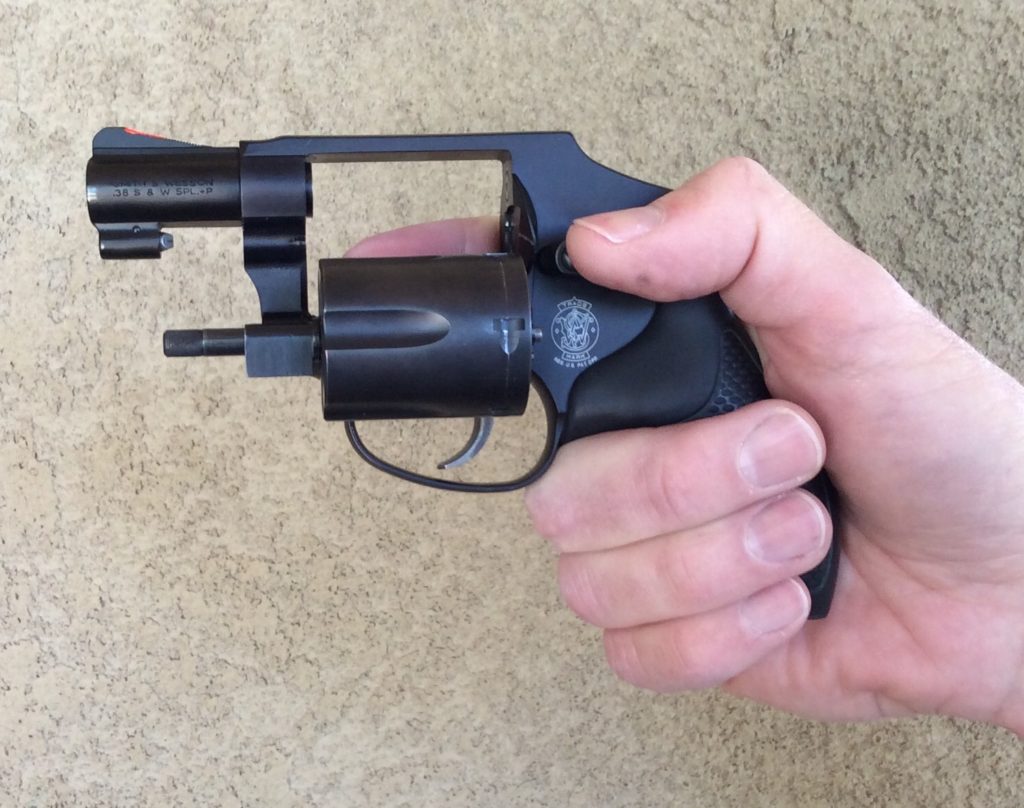
As the thumb operates the release, the index finger will push the cylinder out while the others maintain their grip on the firearm. Depending on the size of your hand, the size of the gun, and the type of release, you may have to flip or rotate the gun in your hand a bit to accomplish this.
An alternative to using the index finger is to strike the cylinder on a knee (or a thigh, or anything else that’s handy) to push it open as you hold the release with the thumb. You might also be able to flip the cylinder open with a flick of the wrist while operating the release—not a practice that you’d want to regularly engage in, but suitable for an emergency. Whatever you do, just don’t strike or flip the gun so hard that you drop it.
Now comes the tricky part. To clear the cases from the cylinder, you can use one of several methods. Once again, your choice will be determined by factors such as hand and frame size.
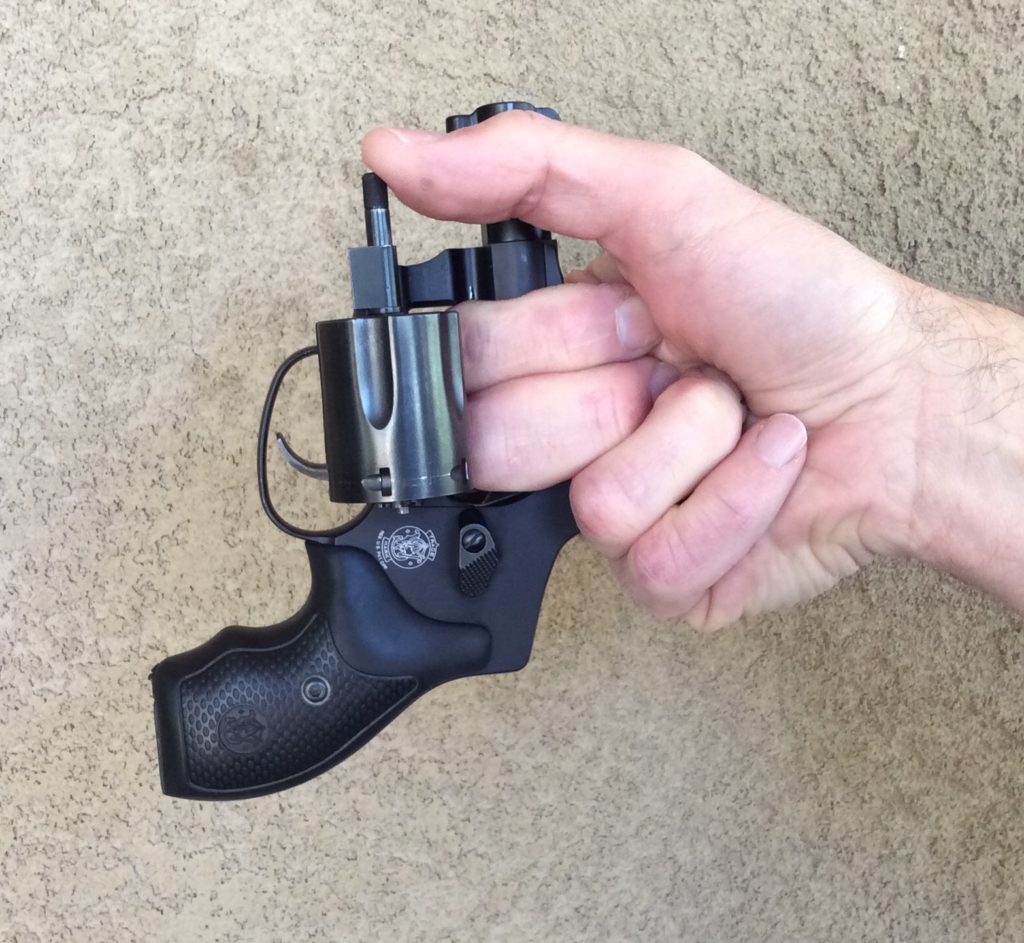
You might choose to run the index and middle fingers through the right side of the cylinder window and grip the top strap of the frame in a way that would allow you to invert the gun (so the chambers are pointing at the ground) and run the ejector rod with your thumb. Alternatively, you might put your index finger deep into the right side of the cylinder window to hold the cylinder open, hold the back of the frame/hammer with your thumb, invert the gun, and run the ejector rod with your middle finger.
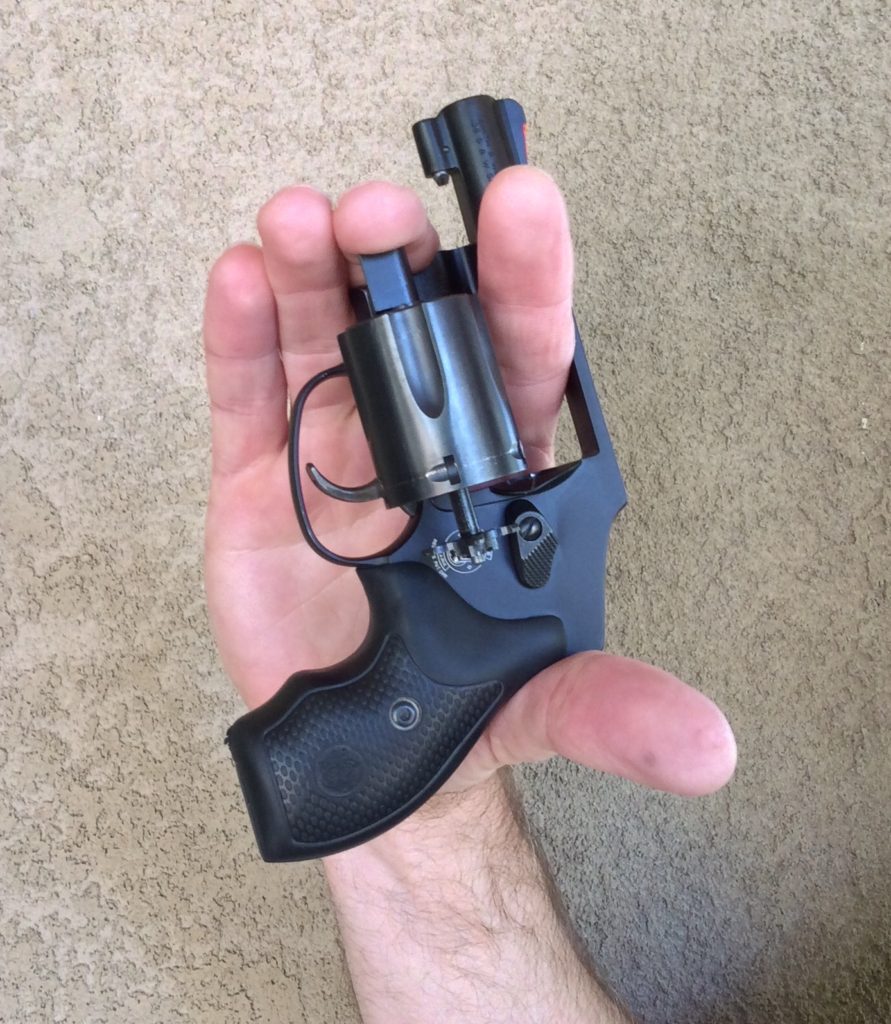
The primary advantage to these methods is that the gun can be held with the muzzle up and the chamber mouths pointing at the ground, with nothing aft of the cylinder to block the path of the ejecting cases. This will allow a clean ejection, and prevent a time-robbing malfunction.
There are other workarounds available to the creative mind. The ejector rod can be pushed into the corner of a wall, the edge of a door, the side of a knee, or just about anything else that will allow a full stroke. The advantage here is that you may not have to change your firing grip very much, if at all, which reduces the possibility of dropping the gun under stress. The disadvantage is that most surfaces will require you to hold the gun with the bore parallel to the ground, which isn’t optimum for clearing the spent cases. It’s a lot better if the gun can be inverted with the muzzle pointing skyward, to allow those spent cases (and other residue, such as unburned powder or soot) to fall free of the gun completely, and not get trapped underneath the ejector star on their trip to the ground. Additionally, fingers left on the grip may get in the way of ejecting cases (removing the middle finger from the grip may create sufficient clearance).
Unloading (Left Hand)
If the left hand is the one that works, either the thumb or the index finger will need to operate the release, as the right side of the cylinder is pushed against a body part (knee, thigh, chest, whatever) or something else to pop it open.
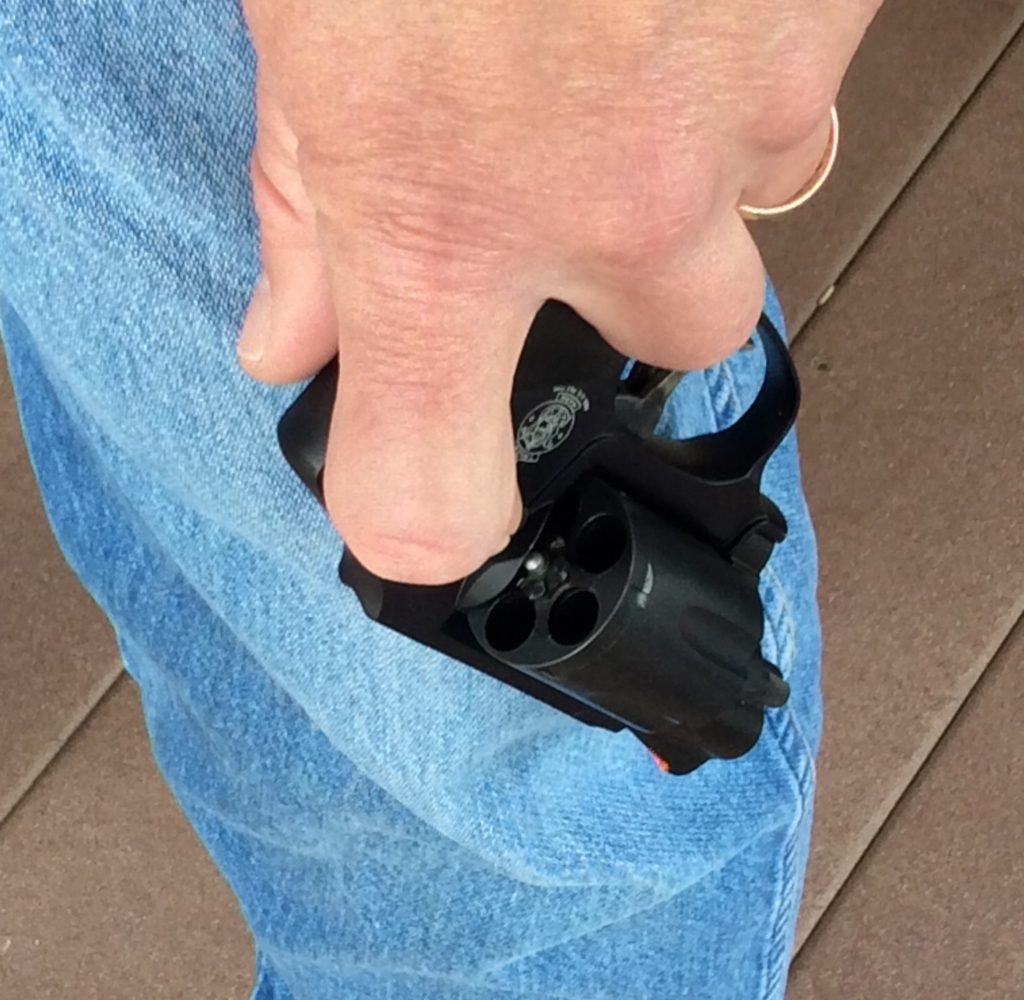
Once that’s done, we need to get the gun into a position where we can run the ejector rod. To accomplish this maneuver, I recommend placing the right side of the frame against your chest (muzzle pointing to your right) and trapping it there with hand pressure as you change your grip on the gun. Bring your thumb over to the left side of the grip, drive it into the left side of the cylinder window, and let it wrap around the cylinder as the fingers of your hand move to take a position underneath the trigger guard area.
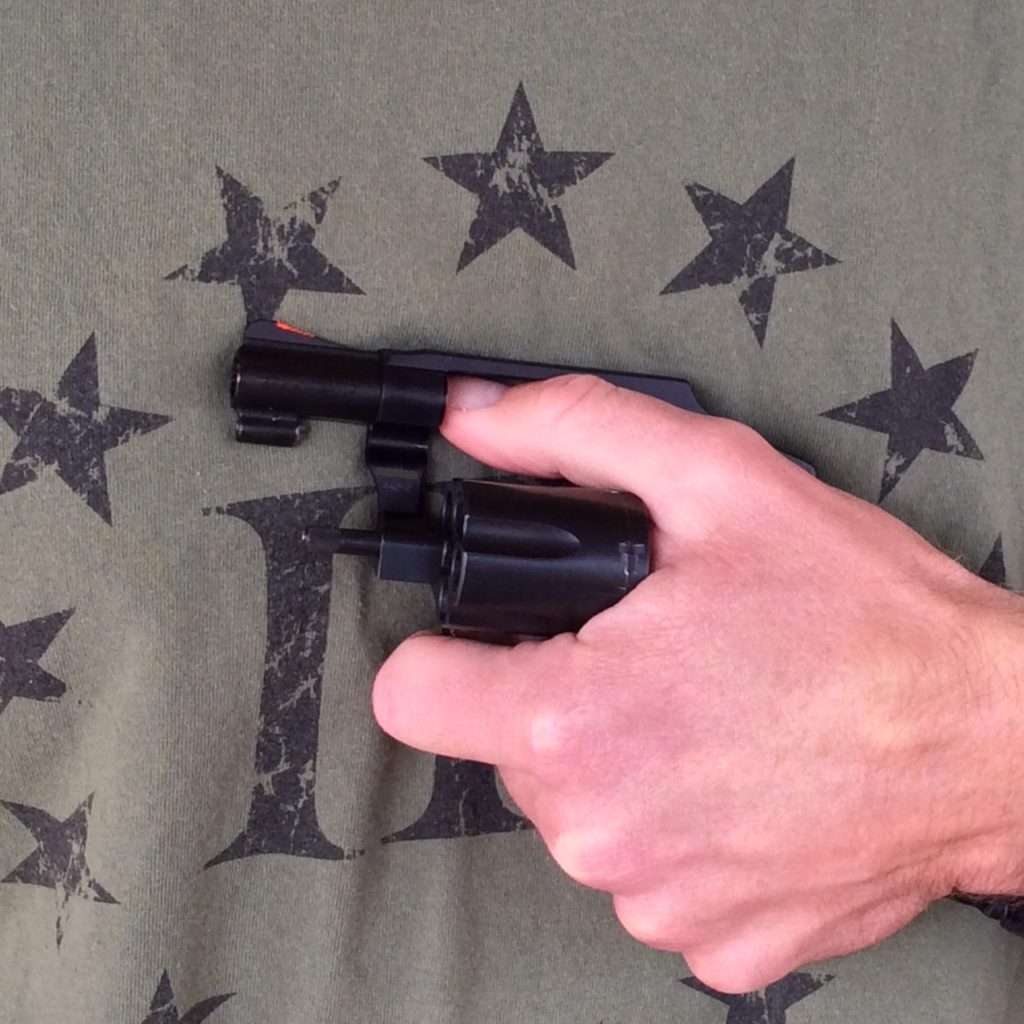
Once you’re there, roll the gun so that the base of the grip is now pointing outboard (while keeping the topstrap trapped against your chest), and run your middle and ring finger through the right side of the cylinder window. Let the middle and ring finger wrap around the cylinder and hold it in the open position, as your index and pinky fingers wrap over the top strap to grip and stabilize the gun.
 Now, point the muzzle skyward and run the ejector rod with the tip of your thumb. Because the area aft of the cylinder is completely clear, you should have a clean ejection.
Now, point the muzzle skyward and run the ejector rod with the tip of your thumb. Because the area aft of the cylinder is completely clear, you should have a clean ejection.
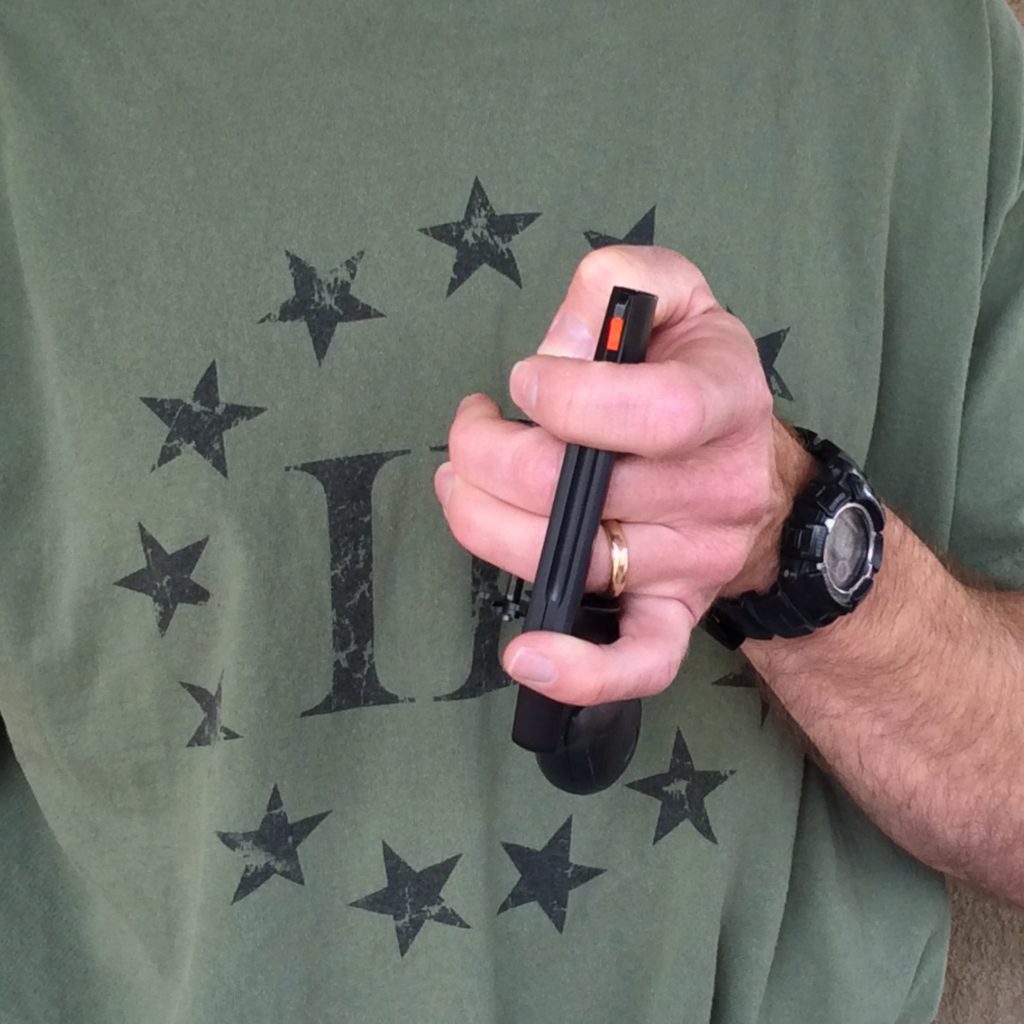
Staging (Right or Left Hand)
Regardless of which hand is now holding the gun, or how it is gripping it after the spent cases are ejected, it’s now time to stage the gun for the reload.
The objective here is to orient the gun with the muzzle down and the cylinder open, in a place where the gun will be stable and secure enough to effect the reload. The time-honored places for this are in the top of a boot/shoe, or in the waistband, behind the belt.
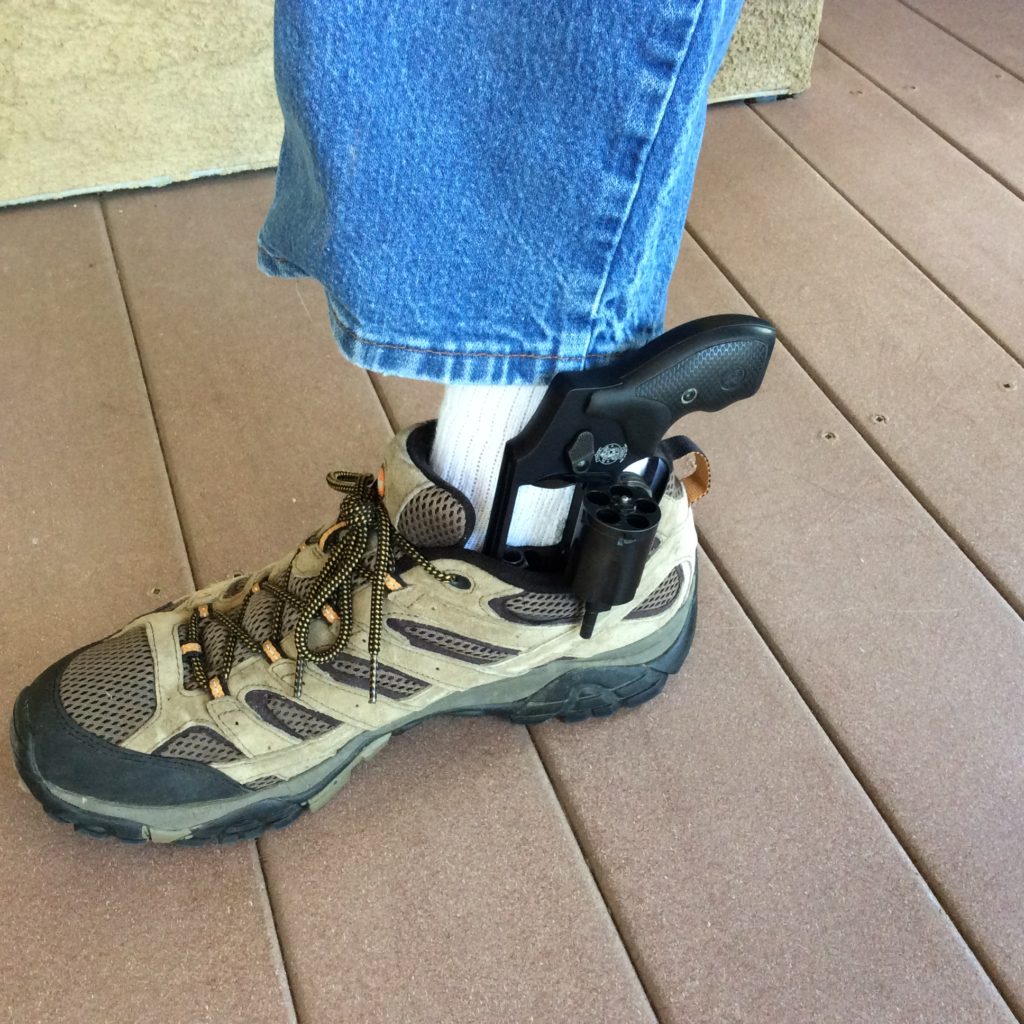
If a boot top is where you’re going to stash the gun, then it’s probably best to use the inside right (for either hand) or the outside left (for left hand only), but you can make other options work (such as inside left), by pointing the top strap to the rear (“cavalry draw”) if you have to because of your posture or injuries. Drive the barrel as deeply as you can into the boot top to stabilize the gun, making sure to keep the ejector rod on the outside to hold the cylinder open.
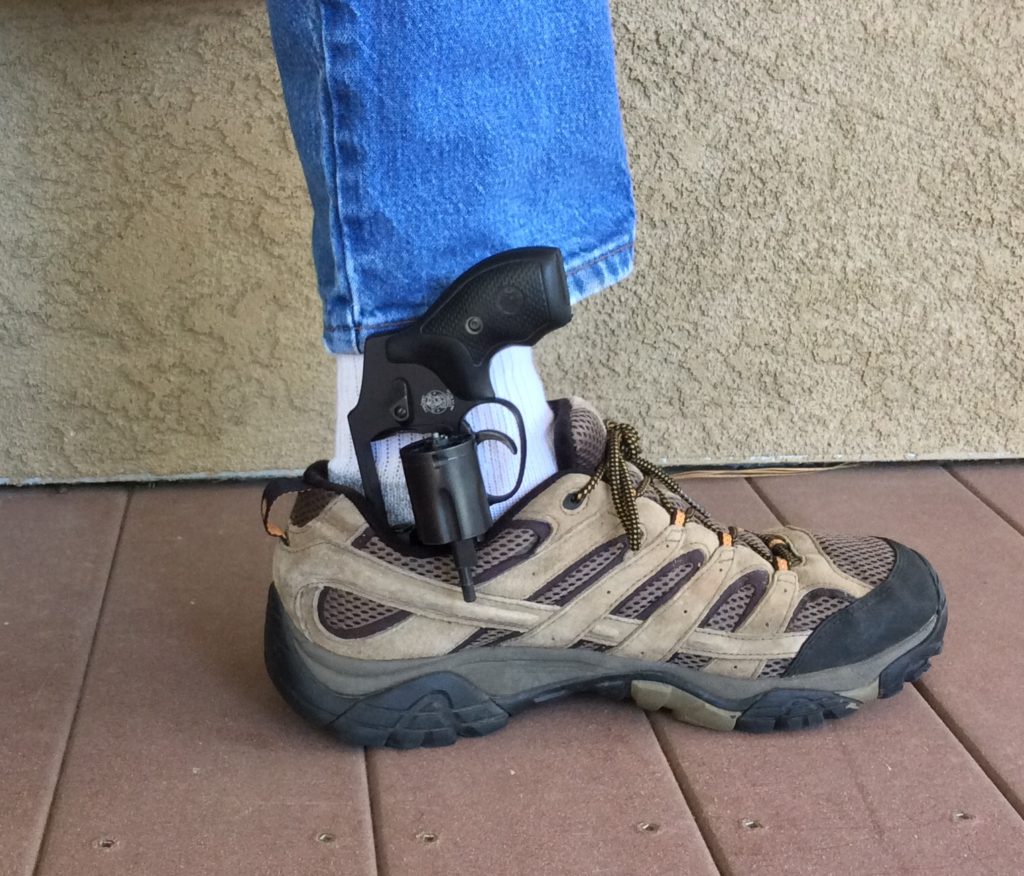
If the waistband is your choice, then move the gun so that the right side of the frame is held flat against your belly, and force the barrel down behind your pants and belt. Once again, ensure that the ejector rod is on the outside of the belt, to hold the cylinder open.
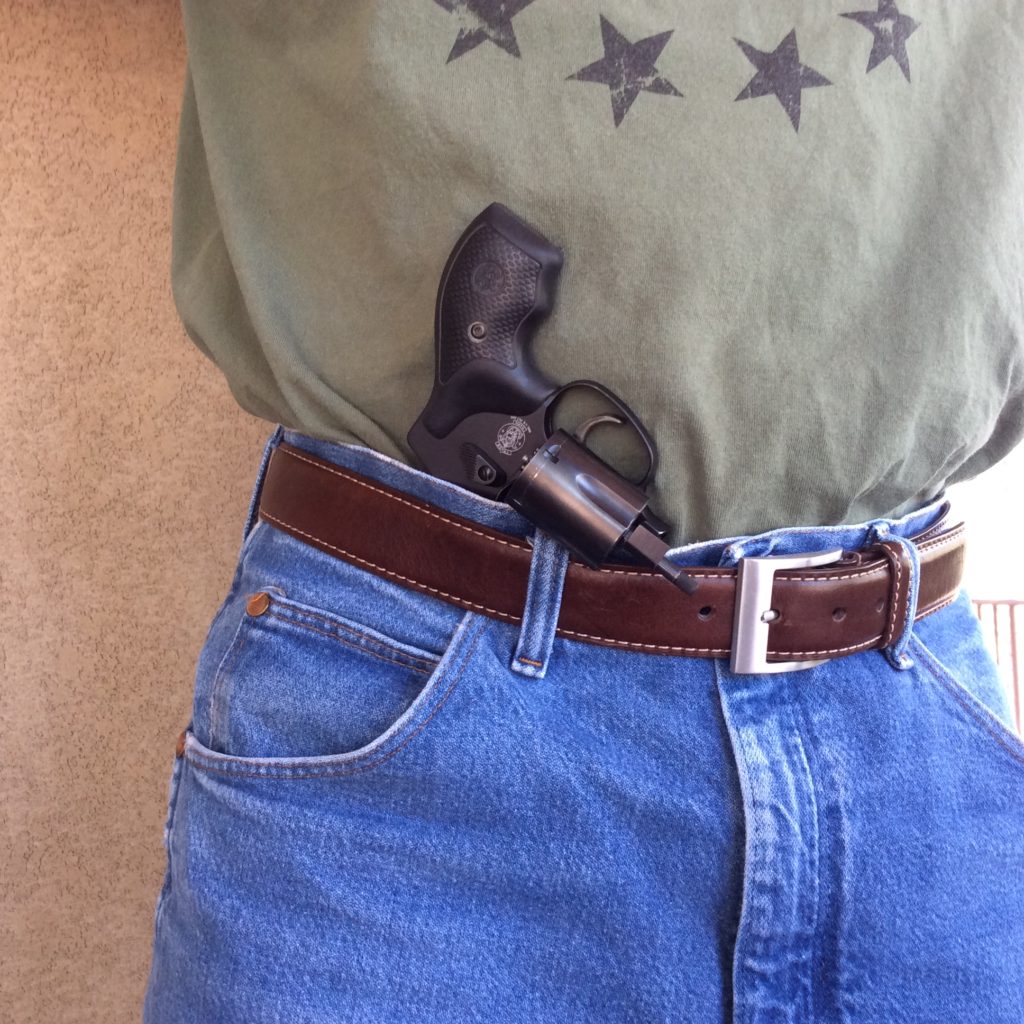
You’ll find that the short barrels on guns like LCRs and J-frames don’t stabilize the gun very well, but they can do the job well enough. One thing that can be helpful with these snubbies is to roll part of the top strap behind the belt or boot top so the gun is inserted at about a 45 degree angle. The extra purchase on the top strap will hold the gun steadier, and prevent it from falling out, but it will also complicate the loading part a bit (and gravity will have less opportunity to help pull the cartridges into the cylinder). The tradeoff may be worth it though, to ensure the gun stays put.
A hip pocket can work well too, and as a last resort, a snubby can even be placed on the ground and steadied by a foot or knee as it’s loaded with the cartridges parallel to the deck. Gravity loaders will require some extra effort to seat the cartridges in place, but a Speed Strip might work pretty well.
Loading (Right or Left Hand)
Loading the cylinder with cartridges will be a little more difficult when you only have one hand, but some loaders will make this process easier than others.
A push-feed speedloader (Dade, Speed Beez, Safariland, SL Variant, JetLoader) will be easier to work with than a speedloader that requires you to twist a knob for cartridge release (HKS, 5-Star), because the latter style will require you to hold the cylinder in place and operate the loader simultaneously with the same hand. While Clint Smith thinks that there’s a mechanical advantage to the counterclockwise release of the 5-Star loader, I don’t agree, and find the clockwise release of the HKS is more intuitive, but either one of these is going to give you more difficulties during a one-handed reload than a push-feed design.
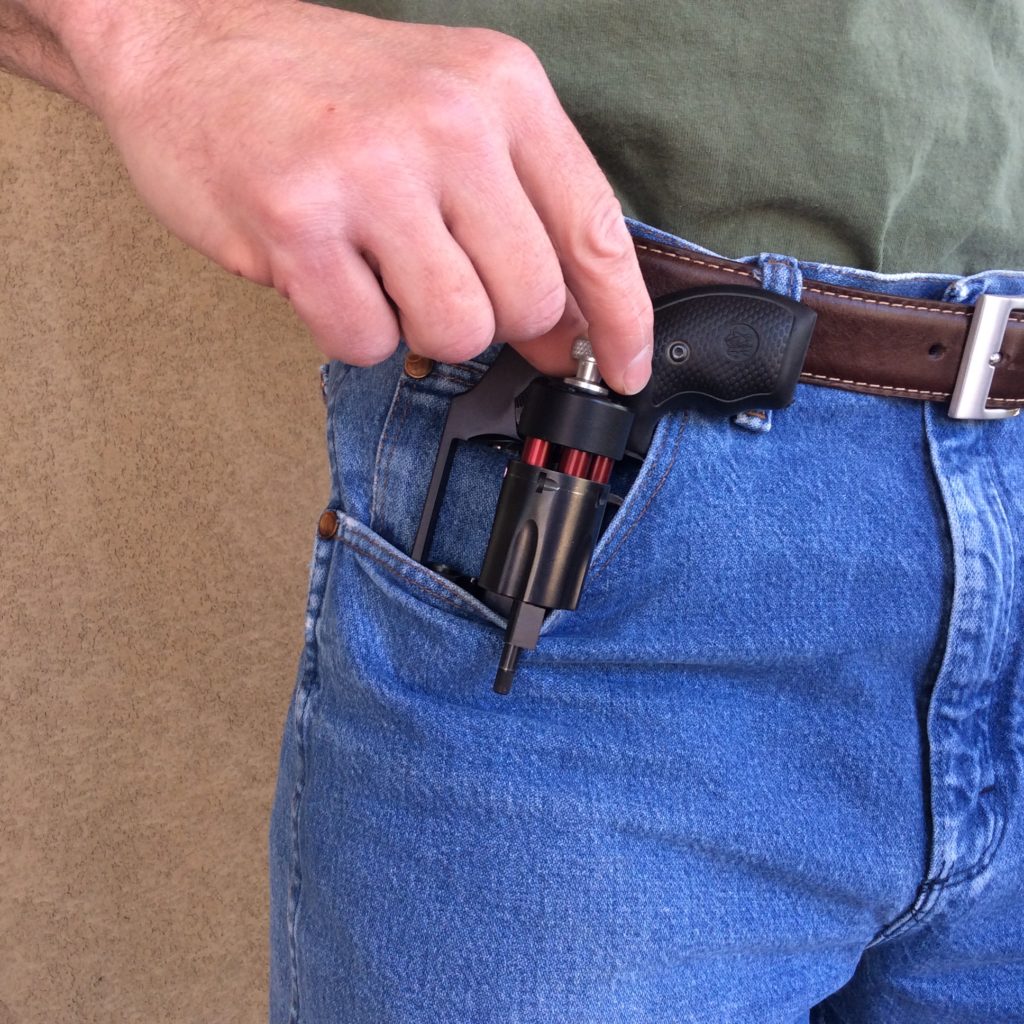
The push-feed speedloaders that are spring assisted (SL Variant, JetLoader) will probably be the easiest of all, because they’re not as dependent on gravity for cartridge seating. In fact, my testing with a K-Frame indicates that the JetLoader will completely seat the cartridges when the gun is lying flat on the deck with the cylinder open, and the SL Variant will almost do the same (half seat completely, the others leave about 0.25” of the case poking outside the chamber—probably due to grip interference) with the gun parallel to the deck. With the gun held mostly vertical in the top of a boot or the waistband, these loaders should seat the cartridges with ease and authority once you get them indexed to the free-spinning cylinder.
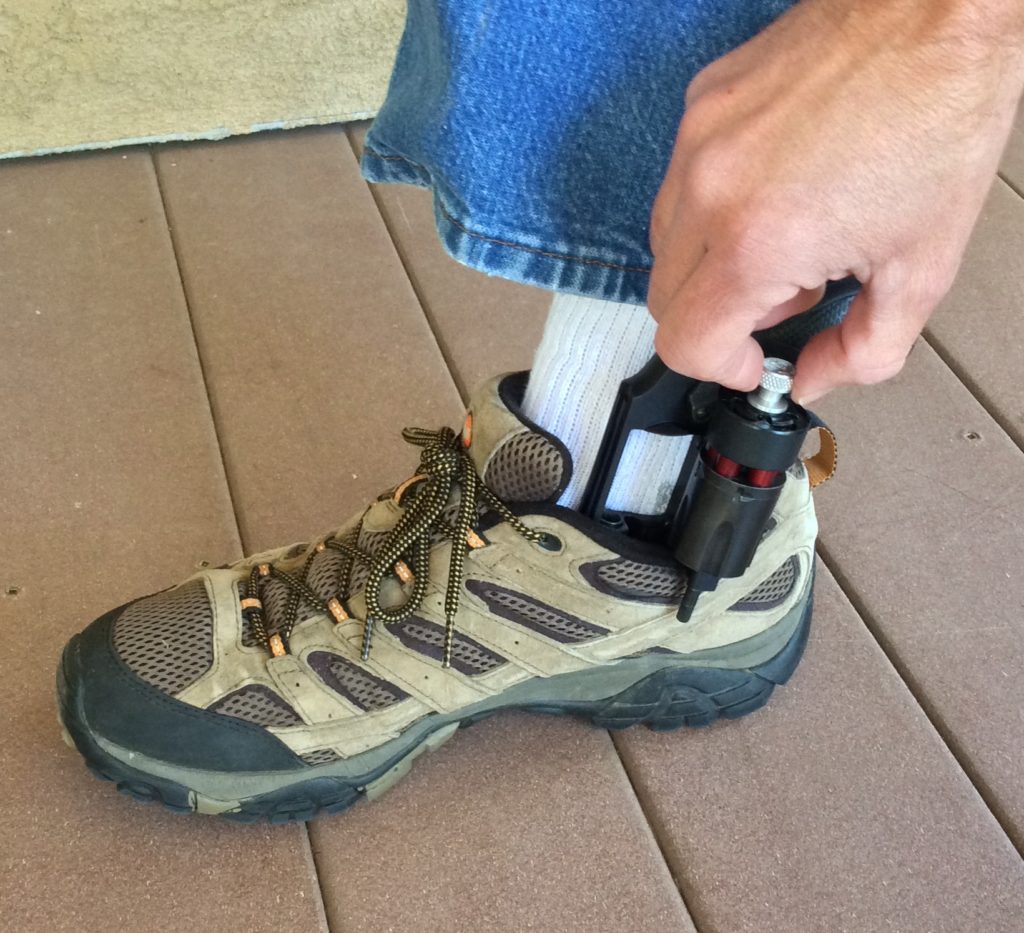
The ubiquitous Speed Strip will certainly work, but care must be taken to ensure that the gun is not pulled out of the boot top or waistband when the loader is peeled away, particularly with the unstable snubbies. As a technique, it might be helpful to peel the loader away towards the body, instead of away, to reduce the possibility of dropping the gun.
Returning to the fight (Right Hand)
After the cylinder is topped off, the gun needs to be grasped and the cylinder closed so that we can get back into the fight. Once again, there are several ways to do this for the right hander.
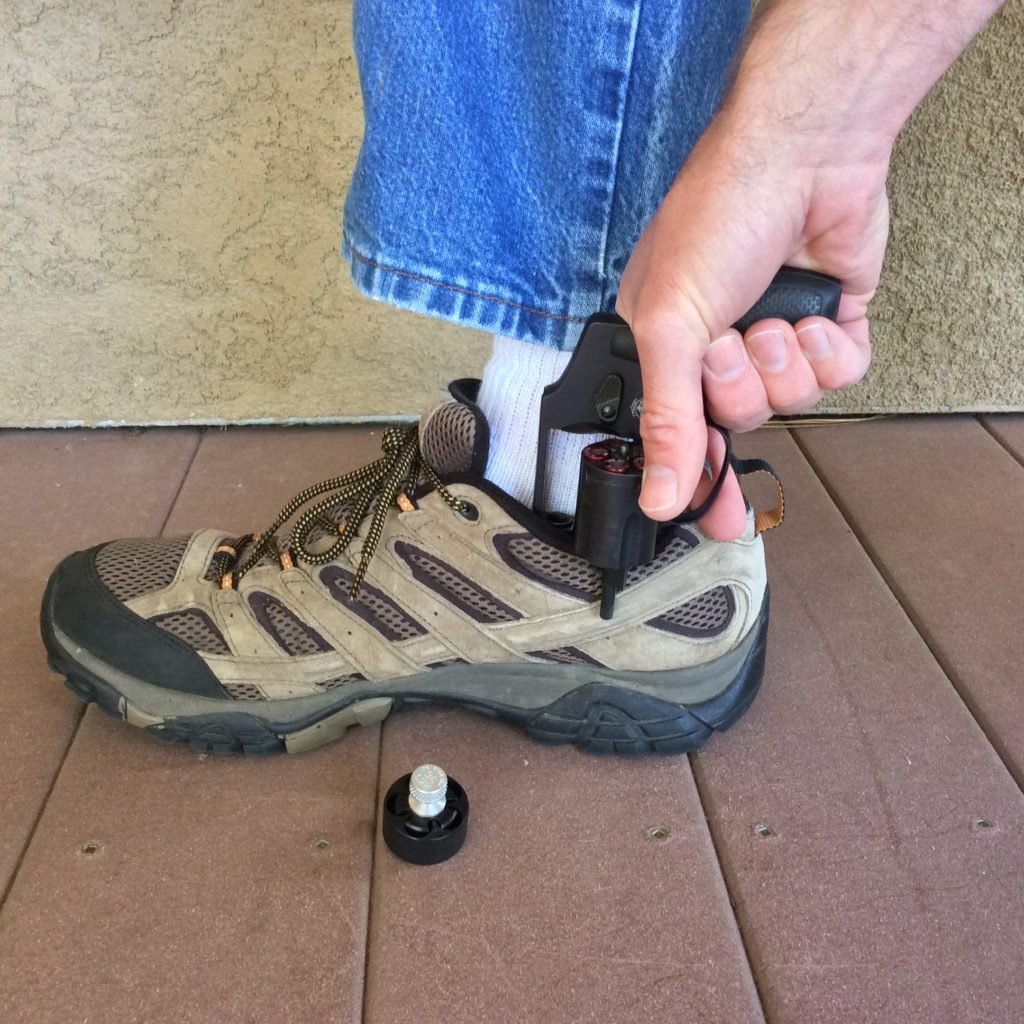
If the gun is tucked into a boot top, the right handed shooter may be able to take a firing grip on the gun and roll the cylinder closed with the thumb, depending on hand and gun size. Failing that, they can achieve a firing grip, lift the gun out of the boot top, and push the cylinder against the leg to lock it into position.
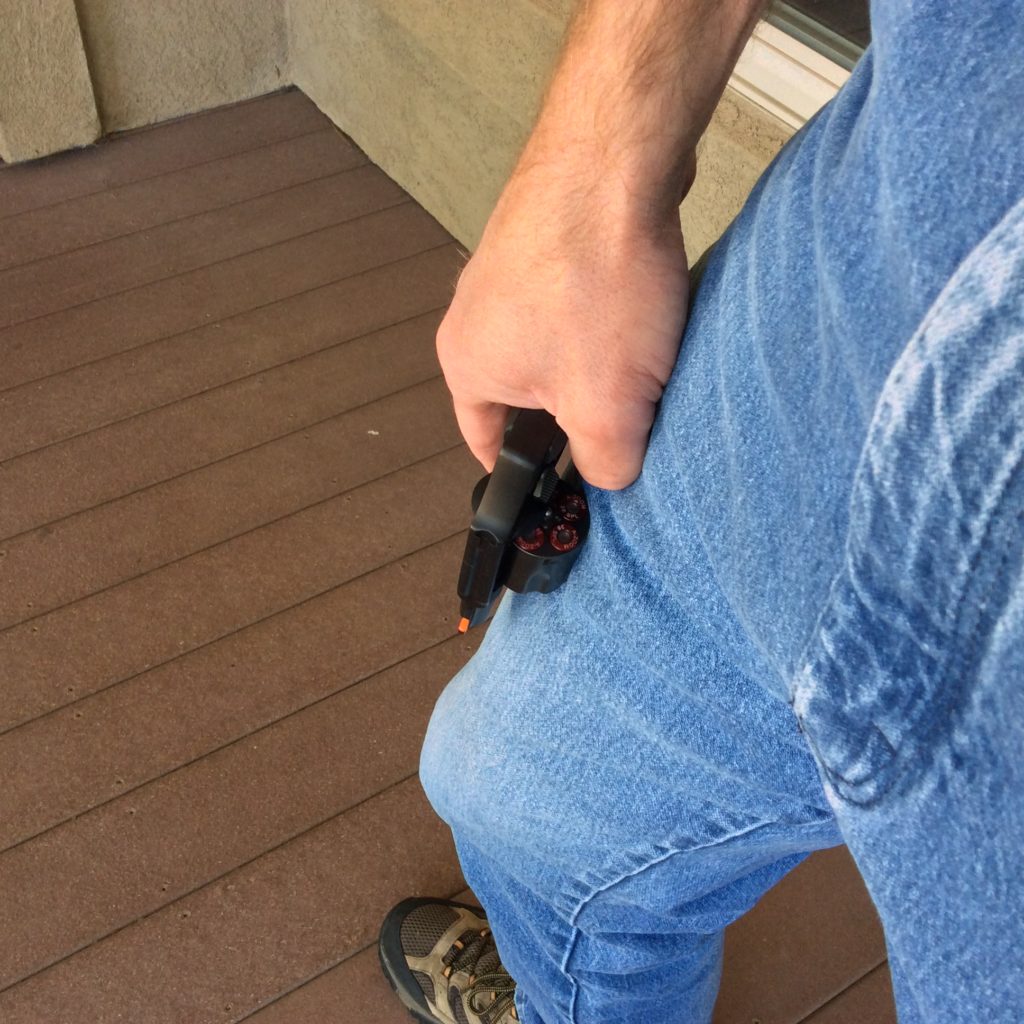
From the waistband, a flexible right hander can use a sort of “cavalry draw” to get the gun into action. Rotate the hand and place the back of the hand against the belly, then achieve a firing grip on the gun. Raise the gun out of the waistband, then uncoil the wrist and rotate the weapon along the vertical axis so that the cylinder is now against the belly, and push the gun into the body (hip, leg, knee) or a piece of equipment (belt, holster, boot) to close and lock the cylinder.
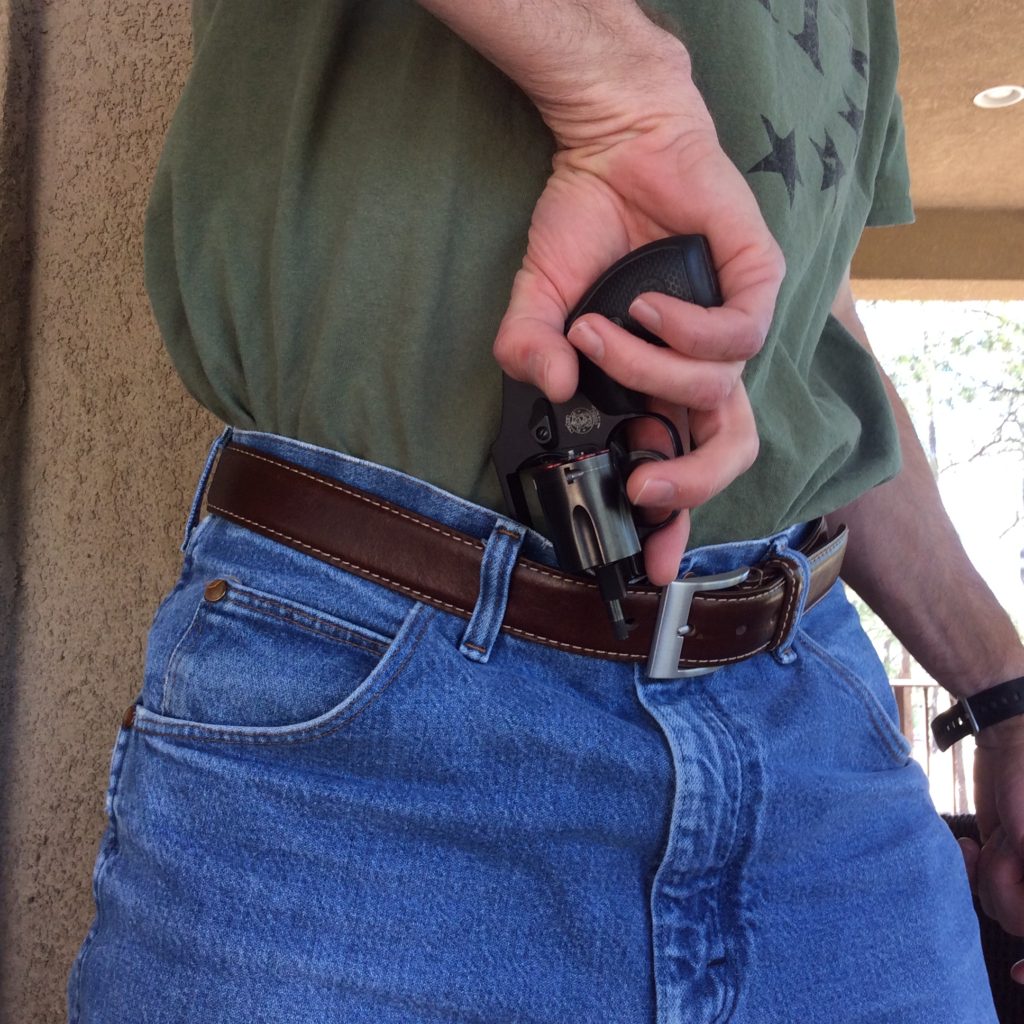
Alternatively, the right hand can lift the gun up out of the waistband and the thumb and fingers can pinch the cylinder shut, using a “C-clamp” with the web of the hand over the top strap. Rotate the gun to place the knuckles and the left side of the frame against the body, and reinsert the gun into the waistband to hold it stable as the hand comes off the gun, reestablishes a firing grip, and draws the weapon. A shooter could also trap the left side of the gun against the body by using inward pressure, then shuffle the hand to establish a firing grip on it, but this method may be more likely to result in a fumbled gun.
Returning to the fight (Left Hand)
The final step is easier for a shooter using their left hand, because the gun is already oriented in the proper direction to obtain a firing grip.
Shooters with the right combination of hand and gun size can achieve a firing grip on the gun, withdraw it from the boot top or waistband, and close the cylinder with the index finger. Failing that, a shooter can achieve a firing grip, withdraw the gun from the boot top or waistband, and close the cylinder by “wiping” it against the body or some other object to lock it into position.
Never give up
None of these techniques will be easy–or fast–to accomplish when you’re injured and suffering from the effects of stress, but if your preparations have been adequate, then you’ll know what to do and you’ll know that you can do it.
If you’re ever stuck in this situation, the most important key to success won’t be the amount of one-handed reloading reps that you’ve done in training, but instead your ability to remain calm and focused under stress, and your indomitable fighting spirit. The right mental preparation here will be far more important than the physical preparation, so do your “tactical daydreaming,” mental imagery, and other exercises to keep your mind right.
Keep your head. Work the problem. Never give up. Those are the keys to winning any fight, not just one with an empty gun and a wounded wing.
Be safe out there!
*****
*Officer Powers was shot twice with 12 Gauge slugs and grievously wounded, but managed to reload his Ruger .357 Magnum revolver not once, but twice under fire with a single hand! The story of his heroic victory is detailed and analyzed in Brian McKenna’s outstanding book, Officer Down! Lessons From the Streets. Readers interested in attending training at McKenna’s Winning Edge Training company can request contact info for Brian via email to the author via the RevolverGuy contact form.
** I think the tendency to become “threat focused” under stress helps to account for the prevalence of hand and arm injuries in gunfights, as shooters concentrate their fire on the object of their attention, which is often the gun in their opponent’s hand (In many gunfight narratives, it’s clear that the participants focused on the gun itself, rather than the assailant who was shooting it). Additionally, most shooting postures place the weapon close to the centerline of the upper torso, which is where most shooters are trained to engage, anyhow. This increases the probability that a hand or arm will be struck by enemy gunfire, causing injuries that would prevent their use by the shooter.

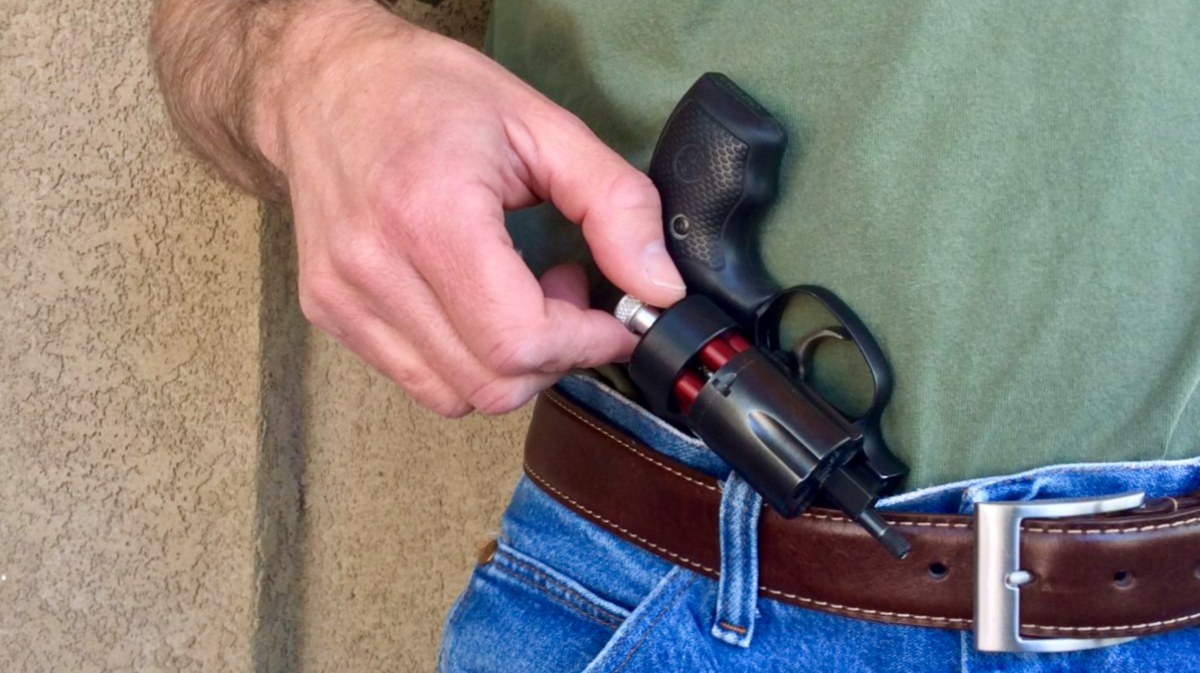
Sheesh! Definitely a good time for a New York reload, if you have one! Were I ever in this situation, I would be thankful for a three inch barrel and the stability it brings…I know I’d be trembling enough to knock a snub out of my waistband almost certainly.
Can’t remember the gun magazine or the year it happened,
perhaps 25 or more years ago, but a DEA agent fired at a bad guy
who also got off a round.
The bad guy was stopped and the agent’s gun was jammed
with the bad guy’s bullet in its barrel.
“Threat focus” certainly played part, at least on the
bad guy’s part as he aimed toward the agent.
Indeed! That’s a helluva story, and proves the point nicely. Thanks Ed.
I have practiced the one hand reloads,,,, and this is my take, YMMV.
For me, the biggest drawback is WHERE I carry reloads/spare ammo on my body. If I ONLY have one hand functional, this could be an issue. Which hand? Which side?
You’re right, that’s an important consideration, Ron. I carry my revolver reloads between 12 and 2, and can get to them with either hand that way. When I carry a speedloader, the pouch goes around 1 O’Clock, and either hand can easily find it. The coin pocket on my Wranglers is where my speed strip usually goes, and I can reach that with my weak hand too.
I think Justin has written in these pages that he carries a speed strip in his left rear pocket and a speedloader up front on the right to solve the dilemma.
Which brings my mind to an even greater issue. That would be WHERE we choose to carry the gun on body! To those out there in reader land that carry only on “strong side”, try this: ATTEMPT to get that gun out of the holster with your support hand.
Agreed, Ron. This is just one of the numerous benefits of appendix carry – being able to safely get the gun out with either hand.
I agree 100%
I know appendix carry gets lots of negative publicity, to each their own. I like options, and being able to get the gun with EITHER hand makes me warm n fuzzy.
Regarding the bullet going from a bad guy’s
gun into a DEA agent’s gun barrel, to clarity:
From what I remember of the story about
two-thirds or three-quarters of the bullet
went part way into the barrel, the rest shaved off
into space.
Another excellent article!
While we likely won’t ever need it…. why not make it a point to practice a few one-handed reloads every time you shoot your revolver(s)?
Can’t hurt…. doesn’t take that much time….. and you never know….
I had previously mentioned to Justin that I roll my eyes at the “tactical-ness” of some one-handed reload articles, so I really appreciate the effort to keep this in perspective. As you pointed out, this isn’t something you want to be figuring out in the moment, but it also isn’t something to dedicate huge amounts of time to. I would also agree with your last point about never giving up. It’s not over ’till it’s over.
Thanks Buddy! Yeah, “context” is something that seems to be lacking in many of these conversations. We like to think that things are a little different here at RevolverGuy, and it makes me happy to hear you agree. We love our guns, but it’s what you’ve got between your ears and in your heart that matters most when things go south.
I carry a 45 colt for bear defence and was trying to picture a scenario of reloading one handed while a bear is chasing me. I guess the waistband method would be my best bet but still a low chance of success. Thanks for the info!
I would definitely recommend listening to Todd Orr’s case study. Todd was attacked by a sow grizzly. Twice. It’s very demonstrative of the fact that attacks (of any kind – man or beast) don’t necessarily happen how we imagine they might.
This is a very low likelihood skill, but it’s not a bad one to have.
https://www.acrossthepeak.com/blog/e024
The old advice of filing down the front sight on your bear gun—so it doesn’t have any sharp corners—comes to mind.
It hurts less that way when the bear sticks it northbound up your south side! ?
One use of a Barami Hip grip or Clip draw is to stage the gun for a one handed reload. You loose the ability of the ejector to hold the cylinder open, but you gain the ability to close the revolver while it is still staged permitting you to go straight to your firing grip when removing it from the staged area. also most of the weight of the gun is hanging below the clip so while it may be jostled free, it’s not reliant on a tight fitting belt or boot and probably more stable than a top heavy arrangement like a snubby sticking out of a loose belt. the nice thing is that you can add one of these to a gun that you normally carry in a conventional holster and it shouldn’t interfer with anything, but it also gives you the ability to drop the gun in your waistband if you are confronted with an unexpected need to run out the door without the time to aquire and set up your holster.
That’s a great recommendation, Joe! Thanks for adding it to the conversation!